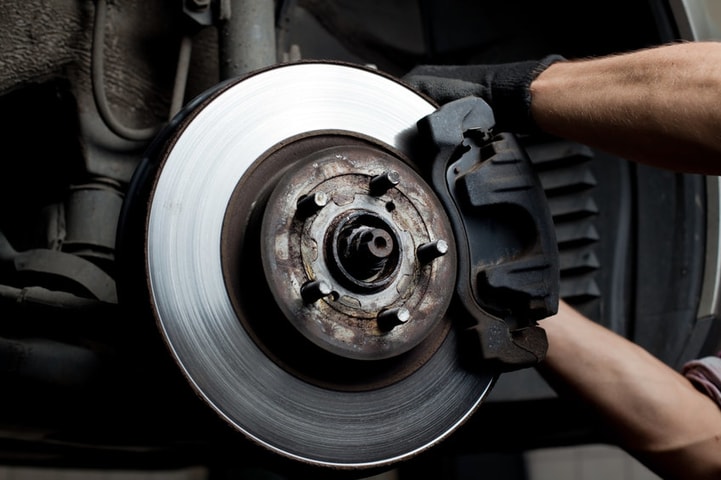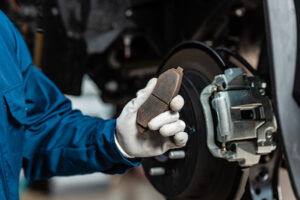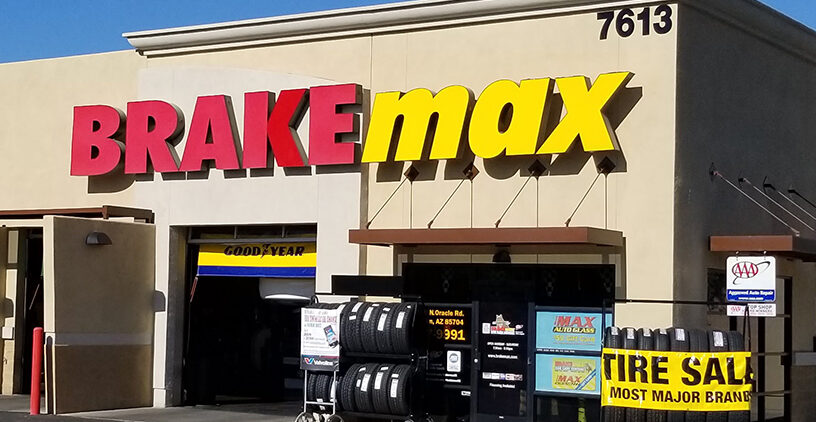How Do Brake Pads Work?

You can save money and a great deal of time by knowing how the systems in your vehicle work. And the brakes are one of the most vital systems of all. It’s easy to take them for granted, though, until they don’t work properly. That can be deadly.
BRAKEmax specializes in keeping braking systems in top condition. The service pros at every location are ready to partner with you, so you know how they work, what problems to look for, and how to keep the braking system healthy to avoid expensive repairs later. BRAKEmax does all brake work, from brake pad repair to a complete brake replacement.
A critical component in the entire brake system is the brake pads. Here is the information you need to know about what they do, how they work, the different kinds of pads, and how to prevent brake problems.
Function of the Brake Pads
A car’s brake system includes:
- Brake Pedal
- Brake Master Cylinder

- Brake Lines
- Rotors/Drums
- Wheel Cylinders
- Brake Pads
The brake pads react by making contact with the rotors when the driver presses on the brake pedal. This results in friction with the rotors, which slows and stops the vehicle. All of this sounds simple, mainly because drivers don’t actually see it happening. All they know is that the car stops.
Brake pads, though, use a great deal of physical force to bring a vehicle to a stop. Due to this stress, they will wear over time, but this wear can be managed first by the driver and then by your BRAKEmax mechanic. Brake pads are meant to last for thousands of miles. Your car’s brake pads can last that long if you take care of them.
There are several different kinds of brake pads based on your needs.
Different Kinds of Brake Pads
The three most common types of brake pads today are metallic brake pads, ceramic brake pads, and organic brake pads. Aside from those, there are also pads designed for motorcycles, trucks, and performance vehicles.
Here are some details on each.
Metallic Brake Pads
The metallic pads are listed first because they are the most common on most cars today. Several metals are mixed together to make these brake pads: steel, copper, graphite, and bonding materials. They are cost-effective, durable, and have good heat-dissipating properties, so they are a good choice for most cars and drivers.
Metallic brake pads, however, are heavy. This affects the fuel economy. They are also very hard, which does make them durable, but it also means they cause more wear on the rotors than other brake pads. Finally, they don’t respond well until they heat up. This can be a problem in very cold climates.
In weighing the advantages and disadvantages, metallic brake pads are generally still considered the best choice for passenger cars. They are not the best choice for high-performance driving because of their weight.
Ceramic Brake Pads
Ceramic brake pads are made with ceramic fibers, bonding agents, and copper fiber. They are lightweight, which is a plus for high-performance vehicles, and their braking performance is good. They are durable and dissipate heat well. They don’t break down with repeated use and produce less dust than other kinds of pads.
They are durable and dissipate heat well. They don’t break down with repeated use and produce less dust than other kinds of pads.
However, they are expensive. Sports car owners often choose ceramic brake pads because they are lightweight. These drivers feel the extra cost is acceptable to keep the weight down on the car. For most drivers, though, that extra performance isn’t necessary on their vehicle, so they are more likely to choose a less expensive pad like metallic or organic.
Organic Brake Pads
Organic brake pads are made from glass, rubber, Kevlar, or resin and are better for the environment. Over time and use, they don’t pollute and are easier to dispose of. They have high heat tolerance, and the heat generated naturally within the brake system binds the materials in the pad together. The materials are softer than other brake pads, resulting in quieter braking.
There are some downsides to organic brake pads. They wear faster, and they create more dust than other pads as they wear.
Overall, organic brake pads are not a good choice for heavy vehicles like trucks or high-performance cars. These vehicles often need to stop quickly while at top speed. Organic pads work best on small vehicles with drivers who, as a rule, don’t need to drive aggressively.
Protecting the Brake Pads in Your Vehicle
Brake pads are under a great deal of stress each time a driver steps on the brake pedal. A car’s wheels rotate fast, yet the pads must grab and hold on to a heavy metal disc and squeeze until the vehicle stops. The friction this produces, and the accompanying heat cause the pads to wear over time. For this reason, it is critical to have the brake pads regularly inspected, along with all the other brake system components. The safety of everyone who rides in or drives the car is too important to neglect this brake maintenance.
Pay Attention to These Signs
You, as the driver, can have an impact on how long the brake pads in your vehicle will last before needing service or replacement. First, you can see the pads through the holes in the wheel, and a quick visual inspection can tell you a great deal. You are checking to assess the thickness of the pads, which should be more than ¼” thick. That is enough to drive the car safely. If they look less than that width, they need to be inspected and possibly replaced.
Pads also have a device built into them that alerts the driver that they need attention. Look for a wear indicator slot down the center of the brake pad. If it’s gone or you can barely see it, get the car to BRAKEmax right away. The wear indicator also triggers the dashboard light to come on or generates a loud squealing noise. These signs tell the driver that there is a problem with the brake pads.
Don’t ignore these signs. Make an appointment now to have the brakes checked.
Your Driving Habits Matter
Your interaction with your brakes as you drive or prepare to drive has an impact on how fast your brakes, including the pads, will wear out.
- Sudden braking puts undue pressure on the brake pads.
- Tailgating leads to many of these sudden stops.
- Speeding more puts pressure on the pads to quickly bring the vehicle to a stop.
- Driving with excess weight in the car requires more momentum and more energy from the brakes to stop.
- Towing another vehicle does the same thing. Detach cars when you reach your destination.
- Not downshifting or using lower gears when going downhill leads to dangerous speeds requiring heavier braking.
Routine Inspections Are Critical
When taking your vehicle in to determine the safety of your brake pads, the mechanic will check the thickness of the pads first. The thickness of new pads varies by make and model of the car. So, their evaluation will be more precise than your visual inspection.
A pad should have more than 20% of the original thickness to be left in place. Thickness can point to an adjustment problem or another defective part.









